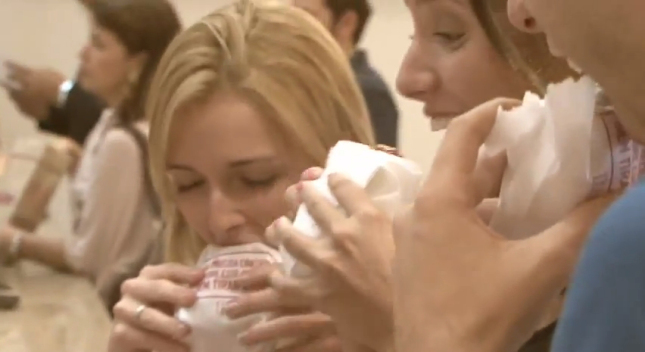Brazilian burger chain Bob’s recently got a lot of press for introducing edible wrappers made of rice paper. With the tagline of “there’s no need to control yourself” emblazoned on the wrappers, the chain said it was testing them for environmental reasons.
Bob’s proclaimed the test a success, with less packaging waste as a result. Here’s a video of customers chowing down on the wrapper/burgers:
If there was a bigger food gimmick in 2012 - and there were many, from bacon sundaes to burgers with black buns - I certainly didn’t see it. What Bob’s and pretty much all the reports on the stunt failed to mention is just how important human senses are when it comes to eating food. The edible wrapper counters several of them.
The brain and senses are hardwired to enjoy certain foods, with our eyes and noses generally acting as the first line of defense. If something looks or smells off, we won’t eat it, which is why there are so few black-coloured foods (black usually means rotten to the brain). It’s how early humans were able to survive long enough for all of us to get here.
It’s also why some of the people in Bob’s video - who were doubtlessly given free burgers if they promised to eat them with wrapper on camera - looked confused before taking a bite. Humans have to consciously trick their brains into eating something sight (or scent) unseen.
One last problem is the texture of the packaging - there’s just no way to track the human brain into thinking that eating paper is fun or desirable.
Harvard professor David Edwards might be on the better track, with his invention last year of WikiCells, a sort of see-through edible packaging made from natural materials. This type of packaging allows consumers to see what they’re eating and it can also be naturally scented, so it can actually add to the desirability. It also doesn’t have a weird texture.


Daniel Friesen
January 16, 2013 at 1:37 am
Don’t forget how pointless this is when you consider the actual reason we wrap foods in packaging.
We wrap foods in packaging so that the food doesn’t come in contact with things in the outside environment we don’t want to eat. The invisible (or visible) filth, dust, etc… comes in contact with the outside of the wrapper instead of the food, leaving the food clean and edible. Even if you drop it before you’re ready to eat.
Try eating the wrapper after that and now you’re eating the filth that the wrapper was supposed to protect the food from. You’re going to need a wrapper for the wrapper.
Marc Venot
January 16, 2013 at 3:20 am
The remark of D. Friesen has value when it’s a take away order but it can be also only to keep the stuff inside. So it has to be a choice.
Maybe a cover based on shrimp chip (those give a hydrophilic sensation when you place your tongue on them) with a kind of varnish on the outside, but then it’s rigid.
Chris C.
January 16, 2013 at 4:01 am
Edible wrappers? Great idea, but aren’t we forgetting something here? It’s been done already and it’s so ubiquitous that we’ve become completely blind to it: Bread, in the invention of the Earl of Sandwich
robinbtaylor
January 16, 2013 at 5:32 am
Interesting; when I saw these, I did wonder about the taste/texture! - I like the attempt at innovation although like Chris said, it’s not a new thing (pills/tablets have been using disolvable plastics for a long time - and rice paper has been used in confectionery for ages) - anything that makes the eating experience more pleasurable and convenient is good in the fast food environment. Unfortunately it seems that this concept needs more work!